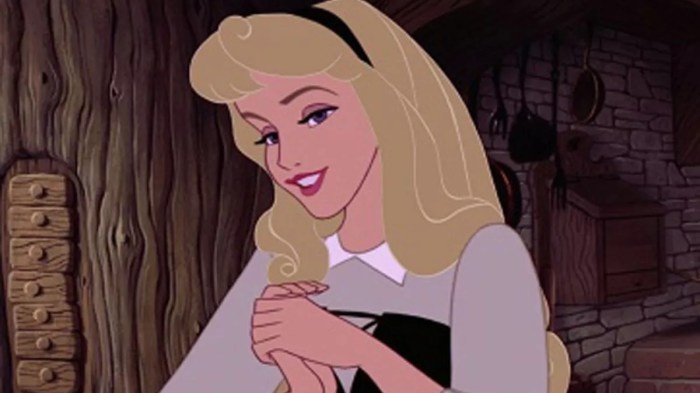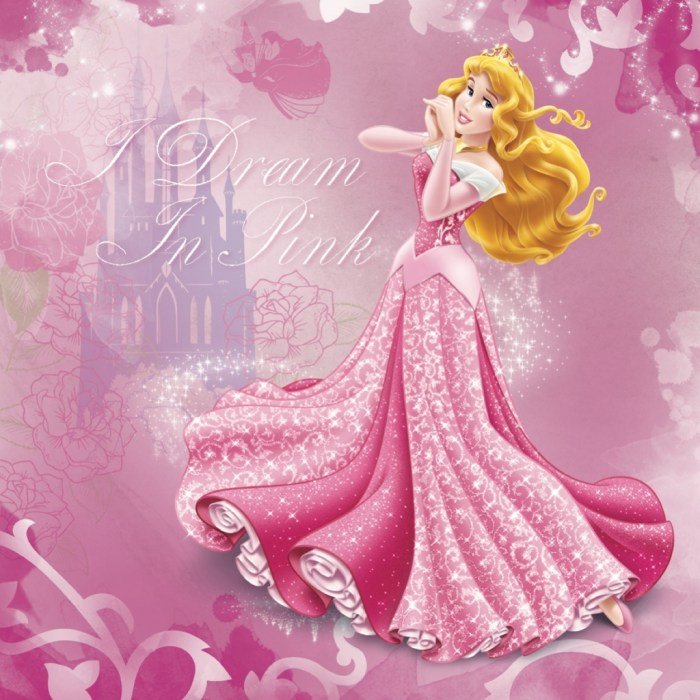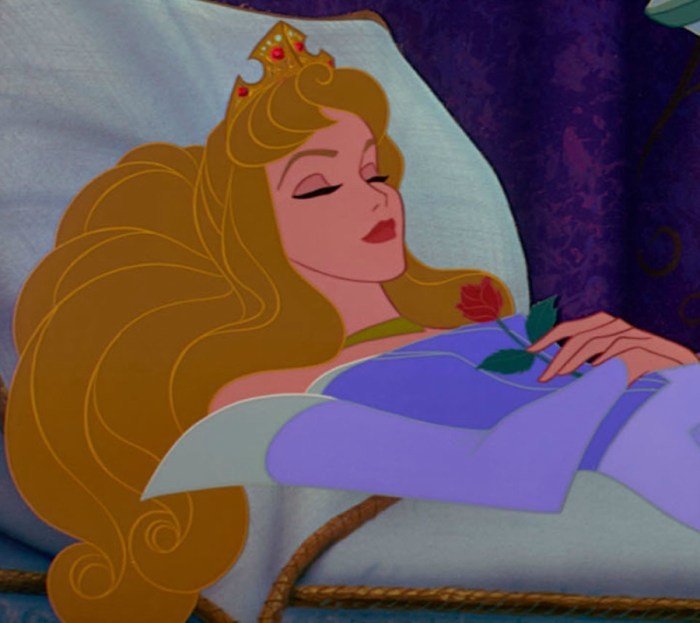Sleeping Beauty Aurora, a name synonymous with slumber and awakening, stands as a central figure in one of the world’s most enduring fairy tales. Her story, a tapestry woven with threads of magic, love, and destiny, has captivated audiences for centuries, evolving through diverse cultural interpretations and artistic expressions.
From the ancient folklore that first sparked her legend to the animated Disney classic that cemented her place in popular culture, Aurora’s journey has resonated with readers and viewers across generations. Her transformation from a slumbering princess to a radiant queen embodies the themes of rebirth, love, and the triumph of good over evil, making her a timeless symbol of hope and enduring beauty.
Sleeping Beauty’s Origins and Evolution

The tale of Sleeping Beauty, a princess cursed to sleep for a hundred years, is a timeless classic woven into the fabric of Western culture. Its origins can be traced back to ancient folklore and mythology, evolving through various literary and cinematic adaptations over centuries.
This exploration delves into the Sleeping Beauty narrative’s fascinating journey from its roots in oral traditions to its enduring presence in modern storytelling.
Origins in Folklore and Mythology
The Sleeping Beauty story draws inspiration from ancient folktales and mythological narratives. The core elements of a sleeping princess, a curse, and a prince’s awakening resonate with themes found in various cultures worldwide. One prominent influence is the Greek myth of Persephone, the goddess of the underworld, who is abducted by Hades and forced to spend a third of the year in the underworld, representing the cyclical nature of seasons and the inevitability of death and rebirth.
This myth echoes the motif of a princess being taken away and the subsequent restoration of balance through a prince’s intervention.
Versions Across Cultures
The Sleeping Beauty narrative has been retold and adapted across various cultures, resulting in diverse interpretations and variations.
- The Sun, the Moon, and Talia(Italian folktale): This version, dating back to the 16th century, features a princess named Talia who falls into a deep sleep after pricking her finger on a spindle. She is discovered by a king who impregnates her while she sleeps, and their children eventually awaken her.
Unlike the traditional Sleeping Beauty story, Talia’s awakening is not due to a prince’s kiss but the natural progression of time and the birth of her children. This version emphasizes themes of fate, divine intervention, and the power of motherhood.
Sleeping Beauty Aurora, a timeless tale of enchantment and slumber, reminds us of the importance of physical well-being. Just like Aurora awoke from her enchanted sleep, we too can awaken our inner strength and vitality. A great place to start is at Crunch Fitness Allen , where a wide range of fitness classes and equipment can help you achieve your fitness goals, just as Aurora eventually found her prince charming.
So, let’s embrace the spirit of Aurora and embark on our own journey of fitness and self-discovery.
- Little Briar Rose(German folktale): This version, collected by the Brothers Grimm in the 19th century, is closer to the modern Sleeping Beauty narrative. It tells the story of a princess cursed to sleep for a hundred years by an evil fairy. She is awakened by a prince’s kiss, and they live happily ever after.
The Grimms’ version highlights the themes of good versus evil, the power of love, and the triumph of virtue over adversity.
- The Sleeping Beauty in the Wood(French folktale): This version, written by Charles Perrault in the 17th century, is considered the most influential version of the Sleeping Beauty story. Perrault’s version introduces elements like the spinning wheel curse, the prince’s kiss, and the evil fairy’s role in the story.
This version focuses on themes of beauty, virtue, and the transformative power of love.
Evolution of the Sleeping Beauty Narrative
The Sleeping Beauty story has undergone significant evolution through various literary and cinematic adaptations.
- Charles Perrault’s “Sleeping Beauty in the Wood”(1697): Perrault’s version introduced elements like the spinning wheel curse, the prince’s kiss, and the evil fairy’s role in the story, shaping the Sleeping Beauty narrative for future adaptations. This version also emphasizes the importance of beauty, virtue, and the transformative power of love.
- The Brothers Grimm’s “Little Briar Rose”(1812): The Grimms’ version introduced a darker tone to the Sleeping Beauty story, emphasizing the themes of good versus evil, the power of love, and the triumph of virtue over adversity. It also incorporated elements of the folktale tradition, such as the inclusion of magical creatures and fantastical elements.
- Tchaikovsky’s “The Sleeping Beauty”(1890): Tchaikovsky’s ballet adaptation of the Sleeping Beauty story transformed the narrative into a grand spectacle, featuring elaborate choreography and beautiful music. The ballet emphasized the romantic themes of love, sacrifice, and redemption, further solidifying the Sleeping Beauty narrative’s place in Western culture.
- Disney’s “Sleeping Beauty”(1959): Disney’s animated adaptation of the Sleeping Beauty story introduced the iconic character of Maleficent, a powerful and evil fairy who curses the princess. This version also emphasized the themes of love, courage, and the importance of following your dreams.
The film’s success further popularized the Sleeping Beauty story, making it a beloved classic for generations.
Aurora: Sleeping Beauty Aurora

Aurora, the titular Sleeping Beauty, embodies a classic fairytale archetype—the beautiful, innocent maiden trapped in a slumbering state. Her journey, however, is far more complex than a simple slumber. Aurora’s character arc traces a path of transformation, from a passive figure to a powerful and independent queen.
Aurora’s Character Arc
Aurora’s character arc can be understood through three distinct phases:
- The Sleeping Princess:In her early years, Aurora is portrayed as a helpless victim, cursed by Maleficent to prick her finger and fall into a deep sleep. She is innocent and naive, her fate entirely dependent on the actions of others.
This phase emphasizes the passivity and vulnerability associated with the traditional damsel-in-distress archetype.
- The Awakening:Aurora’s awakening from her slumber marks a pivotal point in her development. She emerges from her long sleep with a newfound sense of awareness and agency. While still somewhat naive, she is no longer a helpless victim.
This phase emphasizes the transition from passivity to a more active role.
- The Queen:Aurora’s ultimate transformation into a queen solidifies her evolution into a strong and independent figure. She takes on the responsibilities of her role, ruling with grace and wisdom, demonstrating a maturity and self-assurance that was absent in her early years.
This phase signifies the full realization of her potential and the culmination of her character arc.
The Symbolism of Aurora’s Name
Aurora’s name is deeply symbolic, drawing a connection to the dawn, awakening, and rebirth. The word “aurora” itself refers to the celestial phenomenon known as the aurora borealis, a stunning display of light in the sky, often associated with the rising sun.
This connection reinforces the idea of a new beginning, a fresh start, and a breaking free from darkness.
The Significance of Aurora’s Sleep, Sleeping beauty aurora
Aurora’s sleep is not simply a passive state of inactivity. It represents a period of transformation, a time for growth and change. During her sleep, Aurora is shielded from the dangers of the world, allowed to develop and mature in a safe and protected environment.
Her awakening symbolizes a new beginning, a fresh start, and a re-emergence into the world, stronger and more prepared to face the challenges that lie ahead.
The Good and the Evil

The Sleeping Beauty story, like many classic fairy tales, presents a stark contrast between good and evil forces. The tale unfolds as a battle between benevolent characters who embody virtues like love, kindness, and courage, and malevolent characters driven by envy, spite, and a desire for power.
This inherent conflict forms the core of the narrative, shaping the story’s plot and influencing the characters’ actions and motivations.
The Nature of Good and Evil in the Story
The good characters in Sleeping Beauty are primarily defined by their love, compassion, and selfless actions. The three good fairies, Flora, Fauna, and Merryweather, represent this goodness. They are benevolent beings who use their magic to protect Aurora from Maleficent’s curse.
Their actions are driven by love for the princess and a desire to ensure her well-being.
Sleeping Beauty, also known as Aurora, is a beloved Disney princess who is known for her beauty and grace. While she may not need health insurance, many people do. If you’re looking for an insurance provider, you might want to check out Aetna.
You can find their phone number on this website: aetna health insurance phone number. Once you’ve got your health insurance sorted, you can focus on enjoying the magic of Sleeping Beauty’s story.
- The fairies are motivated by love for Aurora and their desire to protect her from harm. They are selfless and compassionate, willing to sacrifice their own well-being for Aurora’s safety.
- The prince, who awakens Aurora from her sleep, represents love and courage. He is willing to risk everything to rescue the princess and break the curse.
In contrast, the evil characters, primarily Maleficent, embody envy, spite, and a thirst for power. Their actions are driven by a desire to control and manipulate others. Maleficent’s motivations stem from her anger and resentment towards the king and queen, whom she believes slighted her by not inviting her to Aurora’s christening.
- Maleficent is fueled by envy and resentment towards the royal family. Her desire for power and control motivates her to curse Aurora.
- Maleficent’s actions are driven by a need for revenge and a desire to inflict suffering. Her cruelty is evident in the curse she places on Aurora.
Cultural and Artistic Influences

Sleeping Beauty, a timeless tale woven from the threads of folklore and fantasy, has captivated audiences for centuries, leaving an indelible mark on art, music, literature, and other forms of cultural expression. The story’s enduring appeal lies in its ability to resonate with universal themes of love, loss, and the triumph of good over evil.
Sleeping Beauty Aurora, with her fair skin and enchanting presence, is a timeless symbol of beauty. Perhaps she visited a glowing beauty bar to enhance her natural radiance, leaving her skin as smooth as silk and her complexion as radiant as the morning sun.
This legendary princess’s captivating beauty is a reminder that a little extra care can make a world of difference.
Artistic Interpretations
The Sleeping Beauty story has inspired countless artistic interpretations, each offering a unique perspective on the classic narrative. From the intricate tapestries of medieval Europe to the vibrant paintings of the Renaissance, Sleeping Beauty has been a recurring motif in art history.
The story’s central image of the sleeping princess, often depicted as a beautiful and innocent maiden, has captured the imagination of artists for generations.
- Medieval Tapestries:One of the earliest artistic representations of Sleeping Beauty can be found in the medieval tapestries of Europe. These tapestries, often woven with intricate details and vibrant colors, depict scenes from the story, including the princess’s slumber, the arrival of the prince, and the defeat of the evil fairy.
The tapestry known as “The Hunt of the Unicorn” (c. 1500) is a notable example, featuring a scene that bears a striking resemblance to the Sleeping Beauty narrative.
- Renaissance Paintings:During the Renaissance, artists like Sandro Botticelli and Raphael incorporated the Sleeping Beauty motif into their paintings. Botticelli’s “The Birth of Venus” (c. 1482-1485) features a sleeping Venus, a figure that evokes the image of the sleeping princess. Raphael’s “The Madonna of the Meadow” (c.
1505) depicts the Virgin Mary cradling the infant Jesus, a scene that echoes the motif of the sleeping princess being awakened by the prince.
Musical Adaptations
The Sleeping Beauty story has also been a popular subject for musical composers, with several operas, ballets, and orchestral works drawing inspiration from the tale.
- Tchaikovsky’s “The Sleeping Beauty” Ballet:One of the most famous musical adaptations of Sleeping Beauty is Pyotr Ilyich Tchaikovsky’s ballet “The Sleeping Beauty” (1890). This grand ballet, with its intricate choreography and sweeping melodies, has become a staple of the classical repertoire.
- Other Musical Works:Other notable musical adaptations of Sleeping Beauty include the opera “La Bella Durmiente” (1908) by the Italian composer Ermanno Wolf-Ferrari and the orchestral work “Sleeping Beauty” (1914) by the English composer Frederick Delius.
Literary Interpretations
The Sleeping Beauty story has been retold and reinterpreted countless times in literature, with authors drawing inspiration from the classic narrative to create their own unique versions of the tale.
- Grimms’ Fairy Tales:The Brothers Grimm, in their famous collection of fairy tales, included a version of Sleeping Beauty titled “Little Briar Rose” (1812). Their version, while similar to the original, incorporates elements of folklore and moral lessons.
- Modern Adaptations:In the 20th and 21st centuries, authors have continued to adapt the Sleeping Beauty story, often incorporating contemporary themes and perspectives. For example, the novel “The Sleeping Beauty” (1990) by the American author Rosamund Pilcher offers a romantic and adult take on the classic tale.
Conclusive Thoughts

The story of Sleeping Beauty Aurora continues to enchant and inspire, serving as a reminder that even in the face of darkness and slumber, the promise of awakening and renewal always remains. Her tale transcends cultural boundaries, reminding us of the power of love, the inevitability of destiny, and the enduring allure of a timeless fairy tale.
FAQ Summary
What is the significance of Aurora’s name?
Aurora’s name is derived from the Roman goddess of dawn, symbolizing the awakening and rebirth that she undergoes in the story. It also connects to the themes of light and hope that ultimately prevail over darkness and slumber.
What is the difference between the original Sleeping Beauty story and the Disney version?
The Disney version of Sleeping Beauty, while inspired by the original fairy tale, features significant changes to the plot and characterization. The original story is darker and more violent, with the prince marrying Aurora while she is still asleep. Disney’s adaptation softens these elements, focusing on themes of love, redemption, and the triumph of good over evil.
How does Sleeping Beauty relate to other fairy tales?
Sleeping Beauty shares common themes and elements with other fairy tales, such as the presence of a magical curse, the importance of love and destiny, and the struggle between good and evil. It also echoes the motif of the sleeping princess, which is found in numerous folktales across different cultures.